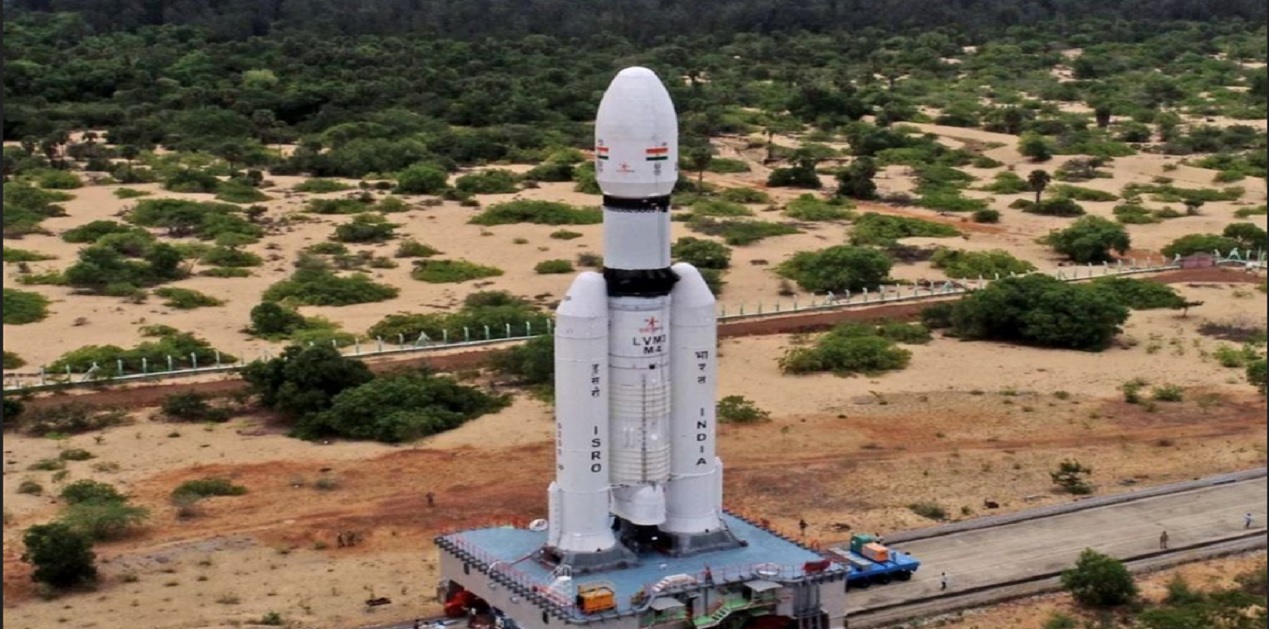The project ‘Chandrayaan-3’ is an ambitious endeavour by India's National Space Research Organisation (ISRO) to demonstrate end-to-end landing and roaming capabilities by deploying a lander and rover on the lunar highlands near the South Pole in the August 2023 timeframe. The spacecraft will also do various surface and orbital scientific studies. The lander/rover and the power module are the two primary components. The lander/rover will have certain similarities with Chandrayaan-2's Vikram rover, but with improved security measures. The propulsion module will send the satellite into lunar orbit and use it as a communications relay for the duration of its mission. The rover will be equipped with spectrometers, a seismometer, and a heat flow experiment.[1]
Successfully launching 342 foreign satellites from 34 nations and 114 spacecraft missions (3 nano satellites and 1 micro satellite) speak about ISRO's proficiency in this field.[2] Various successful launches of space missions include the following missions.
The first lunar mission, Chandrayaan-1, successfully functioned for 312 days till it ran out of fuel on August 25, 2009. The scheduled launch date for the mission was October 22, 2008. After India's lunar mission, Chandrayan-1, found water on the moon's surface, the country was propelled to the forefront of scientific discoveries. The National Aeronautics and Space Administration (NASA) of the United States, as well as its foreign colleagues, reacted to the study with a great deal of alarm.[3]
Mars Orbiter Mission (MOM), which began on November 5, 2013, is another well-known instance. The spacecraft entered Mars orbit for the first time on September 24, 2014, making history with this achievement. Even though it was only supposed to serve for a year, Mangalyaan continued to operate until September 24, 2020; that's about six years longer than its initial lifespan.[4]
From the Satish Dhawan Space Centre in Sriharikota, Andhra Pradesh, ISRO successfully launched India's largest Launch Vehicle (LVM3) rocket carrying 36 satellites. ISRO launched LVM3, the world's biggest rocket, on March 26, 2023. One Web Group in the United Kingdom owned LVM3.[5]
Chandrayaan-2v/s Chandrayaan-3
Despite the disappointment of over a billion people when the Chandrayaan-2’s lander-rover crash-landed on the moon's surface in 2019. About four years have passed since the Chandrayaan-2 mission, now ISRO is preparing to launch the Chandrayaan-3 mission in July 2023.
According to the ISRO inputs, unlike its predecessor, Chandrayaan-2, which included the Vikram Lander, Pragyan Rover, and an orbiter, Chandrayaan-3 will use the Vikram lander and the Pragyan rover. As opposed to Chandrayaan-2, which only had one camera, Chandrayaan-3 has two cameras for finding and avoiding danger while landing on the surface of moon. When the lander gets close to the lunar surface, camera inputs will be relayed to the lunar orbiter and the people in charge of the expedition.
Nevertheless, the Chandrayaan-3 mission's propulsion module will only carry the Spectro-polarimetery of the Habitable Planet Earth (SHAPE) instrument to study Earth's spectrum and provide data concerning habitable planets. The lunar South Pole is the landing spot for both expeditions. Chandrayaan-3, like Chandrayaan-2, will have a total time spent on the expedition will be 12 months. In order to successfully complete the objectives of the mission, Lander is outfitted with a variety of cutting-edge technologies. A comparative chart between Chandrayaan-2 and Chandrayaan-3 has been appended below for the purpose of conducting a contrast analysis.[6]
Cutting-edge Technology
"Science on the Moon" is the overarching goal of the expedition. The Chandrayaan-3 spacecraft incorporates state-of-the-art technologies to ensure successful mission completion considering the mission-theme. The fuel capacity of the Chandrayaan-3 has been augmented and the landing legs have undergone fortification. The device boasts improved solar panels, which facilitate a greater output of energy, and is outfitted with supplementary sensors. The mission is facilitated by the utilisation of a state-of-the-art 'Laser Doppler Velocimeter' which provides accurate velocity measurements, thereby enabling meticulous management of the mission's advancement.[7]
The lunar lander and rover are scheduled to execute a gentle touchdown in the southern polar region of the Moon, specifically at coordinates 69.37 S and 32.35 E. The desired velocity for touchdown is below 2 m/s in the vertical direction and 0.5 m/s in the horizontal direction. The satellite/propulsion module designated for communication relay purposes will remain in the lunar orbit to ensure uninterrupted connectivity with the Earth. The operational lifespan of the lander and rover is limited to a single lunar day, which is equivalent to approximately 14 Earth days.[8]
The objective of the mission is to successfully execute a landing on the surface and subsequently deploy the rover, despite the formidable challenges posed by the terrain.[9] Chandrayaan-3 is set to establish an elliptical parking orbit with dimensions of approximately 170 by 36,500 km. The proposed approach entails the deployment of a lander/rover into a polar lunar orbit with a diameter of 100 km, followed by its separation from the thruster module.[10]
Significance of Chandrayaan-3
ISRO has number of projects lined up in the future. These assignments are one-of-a-kind and extremely challenging to accomplish. ISRO's ability to successfully execute out its ambitious plans will benefit from the lessons learned from its history of over 100 successful space missions.
The diverse missions undertaken by the ISRO are characterised by their distinctiveness and require a high degree of professional expertise to ensure their successful accomplishment. Several of these distinctive missions are given below.
XPoSat: ISRO and the Raman scientific facility (RRI), an independent scientific facility in Bengaluru, are working together to create India's first polarimetry mission, dubbed "X-Ray Polarimeter Satellite (XPoSat)". The purpose of this observatory in orbit is to examine the polarisation of X-rays from space. The launch of the mission is planned for later this year. As stated by ISRO, "XPoSat will study various dynamics of bright astronomical X-ray sources in extreme conditions." It's the first of its kind in India and only the second in the world, and it's designed to investigate the complex dynamics of high-energy astronomical X-ray sources. The Imaging X-ray Polarimetry Explorer (IXPE) will be the second such significant mission launched by NASA in 2021.[11]
Gaganyaan: This is India's very first mission to send human beings into space. The launch of the mission is slated for the year 2023, and it will include the placement of three Indian astronauts into orbit around Earth.[12]
Shukrayaan-1: With the help of the French space agency “Centre National D'etudes Spatiales” (CNES) (National Centre for Space Studies), the ISRO is planning to send the "Shukrayyan-1" probe to Venus in the year 2025. The purpose of this mission is to study Venus by exploring its surface and atmosphere.[13]
Mangalyaan-2: This is a second mission to Mars that will study the planet's surface and atmosphere. The mission is scheduled to launch in 2024.[14]
Conclusion
With the Chandrayaan-3 mission by ISRO being prepared for launch, there is widespread anticipation regarding the novel insights that it will potentially yield from the lunar terrain. The intent of the mission is to enhance comprehension of the composition of the Moon. The scheduled launch is set to take place between the 12th and 19th of July in the year 2023, and will be conducted from the Satish Dhawan Space Centre located in Sriharikota, India. The heavy-lift GSLV Mark III rocket is the designated spacecraft for this mission. The ISRO expresses confidence in the lunar landing mission's capability, citing the organization's track record of successful and enduring missions.
The ISRO is currently planning to utilise its robust GSLV Mk III to launch 36 OneWeb broadband satellites into space. The forthcoming launch, slated for the 23rd of October 2023, will be a significant advancement for India's space programme and its aspirations of attaining global leadership in the realm of space exploration.[15] The successful launch of Chandrayaan-3 would potentially invigorate ISRO's future endeavours.
Endnotes
[1] “Chandrayaan-3”, USA.gov, October 28, 2022, https://nssdc.gsfc.nasa.gov/nmc/ spacecraft/ display.action?id =CHANDRYN3. Accessed on June 17, 2023.
[2]https://web.archive.org/web/20220814235204/https://www.isro.gov.in/missions. , Accessed on June 18, 2023.
[3] “How long will Chandrayaan-3 mission last on the Moon? Isro reveals”, India Today, June 15, 2023, https://www.indiatoday.in/science/chandrayaan-3/story/how-long-will-chandrayaan-3-mission-last-on-the-moon-isro-reveals-2393312-2023-06-15. Accessed on June 17, 2023.
[4]Ibid IT.
[5] “ISRO successfully launches India's largest LVM3 rocket with 36 satellites”, Business Today, March 26, 2023,
https://www.businesstoday.in/latest/in-focus/story/isro-successfully Accessed on June 17, 2023.
[6] “Chandrayaan-3”, ISRO, Jun 15, 2023, https://www.isro.gov.in/ISRO_EN/Chandrayaan3_New.html. Accessed on June 17, 2023.
[7]Singh Rahul Sunil kumar, “ISRO chairman reveals Chandrayaan-3 launch date. What sets this project apart?”,
June 14, 2023, https://www.hindustantimes.com/technology/chandrayaan3-latest-updates-launch-dates-isro-chairman-s-somanath-101686747695036.html. Accessed on June 17, 2023.
[8]Ibid nasa.
[9] “What will Chandrayaan-3 do on the Moon? We finally know, India Today”, February 8, 2023, https://www. indiatoday.in/science/story/what-will-chandrayaan-3-do-on-the-moon-we-finally-know-2332022-2023-02-08. Accessed on June 17, 2023.
[10]Ibid nasa.
[11]Sumit Arora, “XPoSat, India’s first polarimetry mission”,ADDA 247, May 30, 2023, https://currentaffairs.adda247.com/xposat-indias-first-polarimetry-mission/. Accessed on June 18, 2023.
[12]TV Venkateswaran, “Gaganyaan mission: Acing the Indian space dream”,
, https://thefederal.com/the-eighth-column/gaganyaan-mission-acing-the-indian-space-dream/. Accessed on June 18, 2023.
[13] “ISRO tolaunch Venusmission “shukrayaan-1” in2025, with France’s CNRS participation”, Affairs Cloud, October 2, 2020, https://affairscloud.com/isro-to-launch-venus-missionshukrayaan-1-in-2025-with-frances-cnrs-participation/. Accessed on June 18, 2023.
[14] “Designed to last six months, India’s Mars Orbiter Mission stops communicating with Earth after 8 long years” OpIndia, October 2, 2022, https://www.opindia.com/2022/10/indias-mars-orbiter-mission-ends-after-8-long-years/. Accessed on June 18, 2023.
[15] “ISRO to launch LVM3-M2 space vehicle to carry 36 OneWeb Internet satellites to space on October 23”, February 20, 2023, https://ddnews.gov.in/blogopinion/isro-launch-lvm3-m2-space-vehicle-carry-36-oneweb-internet-satellites-space-october-23. Accessed on June 18. 2023.
(The paper is the author’s individual scholastic articulation. The author certifies that the article/paper is original in content, unpublished and it has not been submitted for publication/web upload elsewhere, and that the facts and figures quoted are duly referenced, as needed, and are believed to be correct). (The paper does not necessarily represent the organisational stance... More >>
Image Source: https://india.postsen.com/content/uploads/2023/07/07/62cf1ce8e7.jpg











Post new comment